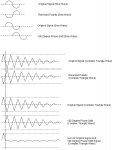O.K., first things first. So far this post has been pretty good about proper usage of the terms phase and polarity, but I will clarify for those who may not be clear on the subject. Phase is an issue of time, and exists anywhere you have waves (whether sound or otherwise, but for our purposes we mean sound waves and the electrical representations of them). Phase shifts can happen for acoustic or electronic reasons. Polarity is just that, the polarity of the electronic representation, which changes the direction the speaker moves during the first period (half) of the sound wave. Polarity is an electronic issue. Just to be clear, there is no polarity involved acoustically, ever. There is also no time element to polarity.
The traditional way of teaching polarity and phase is with sine waves, which can lead some confusion. See the upper demonstration in the attachment. The problem with using sine waves for this is the constant nature of a sine wave. Sine waves do not exist in nature, and have elements which differ drastically from natural wave forms. Natural sound waves change over time, enough so that no two consecutive cycles of a wave are the same. I have always felt that it would make more sense to teach the concepts of phase and polarity with a more complex wave form, so there would be less confusion. See the lower half of the attachment. And the triangle wave I used is still an unnaturally simple wave form, so imagine what happens when you start dealing with a more complex, natural, wave form.
There is a frequent tendency, even among professional engineers, to call all phase incoherencies phase "problems." While it is true that phase issues can frequently be problems when handled poorly, it can also create sounds which are much better than single microphone techniques. Multiple microphones always create phase issues. The polarity switch will make a difference in the sound, but it does not "fix" phase incoherencies. When only one microphone is picking up a sound, you can not hear changes in polarity (no one can), and phase incoherencies do not exist, so the phase can not be shifted. Phase and polarity issues not only can not be heard, but in fact do not exist without multiple signals. The polarity switch still inverts the polarity of a signal, but you can't hear it.
As far as uses for the polarity switch, there are a number. You want to try the polarity both ways anytime you are using more than one mic on a signal. You will almost always need to flip the polarity on the mic on the bottom of a snare drum. The same is true about micing the back side of a guitar cabinet. This is because you have two mics picking up the same sound source, but facing in opposite directions so that the diaphragms end up moving in opposite directions, magnetically speaking. Contrary to many peoples belief, it is not because the drum or speaker put out sound of different polarity on either side. I some times find it helps to try different polarity positions for different instruments in a mix, particularly if they are playing similar parts or if there is a lot of bleed on the tracks. The polarity switch is also used for setting up an M/S stereo mic pattern. If you do a search for Ancient Ribbon Mics in the microphone forum, there is a post where I described step by step how to set up an M/S mic group.
Man I talk too much. Sorry.
Light
"Cowards can never be moral."
M.K. Gandhi

 . But never did I mention phase or say you where wrong.
. But never did I mention phase or say you where wrong. 
